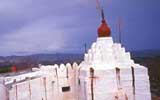|
|
|
|
|
|
||||||
| Features | |||||
|
Indians on India
Indian Music
News Bytes
Survival Tips for Living in Bangalore
Maria's Corner: Late April
Maria's Corner: Early May
|
|||||
|
Travel > Travel India > Boulders and Ruins
Boulders and Ruins Posted by Ted Eugenis, 21 August 2004
Today, a vast array of ruins stimulates the imagination making it easy to envision life of in the prosperous kingdom that ruled southern India. In the 1400s and 1500s, Portuguese, Persian and Italian visitors marvelled at the opulence and riches of a city filled with traders offering gold, pearls, diamonds, fine fabrics and livestock for sale or trade. Several accounts document Hampi's glory ended in 1565 after the battle of Talikota, many miles to the north of Hampi. An army, composed of troops of four sultans, defeated Rama Raja's composite army of Hindu soldiers, Muslim and Portugese mercenaries. But as John Keats points out in his book, A History of India, although Rama Raja was beheaded. the city was far from destroyed by the maurauding army. The battle was 120 kms north of Hampi and much of the populace looted what treasures they could carry and left. Some residents remained and tales of victorious army ransacking the city are well documented but they did obliterate it, as evidenced by the abundance of fairly well preserved ruins. Temples proved to be the least damaged structures and many of the statues remain well preserved. It wasn't until 2002, however, that the Indian goverment decided to develop Hampi as an international travel destination. Why it took so long is a mystery as the area enthralls adults, kids, archaeological visitors, nature lovers and rock climbers. The terrain is spectacular, offering excellent hiking and bouldering, while those with an strong interest in history can easily spend several days wandering through palaces, temples and other ruins. It is easily accessible by bicycle and walking.
Location Located about 350 km northwest of Bangalore, Hampi is a UNESCO World Heritage Site. Temples and ruins are situated in an area about 35 sq. kms, in terrain of undulating hills and huge boulders.
Try and see everything. It's simply enchanting. In the southwest part of the site, you can wander among ancient royal dwellings, temples. soldier's quarters and giant stables, reserved for the finest king's finest elephants. In the north part, holy sites and temples are located. Guide books generally list the King's Palace, Queen's Bath, Lotus Mahal, Elephant stables, the water reservoir, Pushkarni, and a dozen other sites that are must sees (sic). For me, the musical Vithala Temple is the spot you must visit. It has 56 pillars and all are tuned musical instruments. On any given day, the temple has several unofficial guides who will be happy to talk about the pillars and play a few notes deftly rapping their knuckles on the stone each pillar producing a sound of a musical instrument. Courtesy and custom dictate you give them a few (25-100) rupees for their efforts. The temple's courtyard has a large stone chariot, featured in most guideboks, with wheels that once rotated.
A coracle ride across the Tungabhadra river, lies the hamlet of Anegundi, pre-dating Vijayanagar empire and claimed to be older than Hampi. It lies in the mythical kingdom of Kishkinda, ruled by the monkey king Sugriva of Ramayana fame, and believed to be the birthplace of the monkey-god Hanuman. You can also hike to the top of the Hanuman temple. Have a small stick to ward off monkeys that will try and grab your backpack or purse.
Getting There & Accomodations Once in Hospet, get an autorickshaw to Hampi Bazaar and rent a bicycle for 30 rupees a day. Regular KSRTC bus service is also available from Hospet to Hampi. We stayed at a state run Hotel Mayura Bhuvaneshwari, in the neighboring village of Kamalapura, for 750 rupees. There are numerous guest cottages in Hampi and the price and quality vary. Look before you agree to rent a room for the night as it may be a real rat-hole.
|




